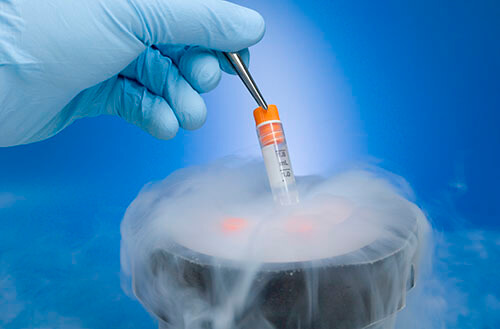Frozen Embryo Transfer

Embryo cryopreservation, or embryo freezing, is a highly useful laboratory technique that was initially used to save the extra embryos that were not transferred in the “fresh” IVF cycle. The excess embryos, which previously would have been discarded, can instead be cryopreserved and used as a backup if the fresh transfer does not work. They can also be stored for several years, thawed, and transferred well into the future, offering parents the opportunity to have sibling children without going through another fresh IVF cycle. Over the years, ACFS gained tremendous experience with embryo cryopreservation, and—with the incredible success of its vitrification program—was one of the first clinics to move almost entirely to frozen embryo transfer (FET). This transition was made for several reasons:
- Newer, better freezing protocols were developed that lead to much higher rates of embryo survival than had ever been observed in the past. The new technique, called vitrification, replaced older “slow freezing” techniques with a fast-freezing protocol that protected the cells of the embryo from cryodamage. Chromosomally normal embryos frozen and thawed at ACFS are expected to survive more than 98% of the time and to result in pregnancy more than 80% of the time.
- We and others observed that frozen-thawed embryos implant at a higher rate than “fresh” embryos transferred immediately following the egg retrieval. This was notable considering that each patient’s top-quality embryos were selected for fresh transfer, whereas the embryos that were not graded quite as well were saved for later use. Many reproductive experts speculated that the ovarian stimulation required to obtain multiple eggs during the IVF process could have a negative impact on the uterine environment or lead to dysynchrony between the embryo and the uterine endometrium, thus reducing the implantation potential of otherwise healthy embryos. Molecular research showed that gene expression in the uterine lining (endometrium) was altered from that of natural cycles or estrogen plus progesterone-prepared cycles. Multiple peer-reviewed clinical studies subsequently confirmed that FET cycles could hold an edge over fresh transfers, especially when patients responded well to fertility medications and produced higher numbers of eggs, or when their progesterone levels started to rise prematurely.
- We were early adopters of preimplantation genetic testing (PGT), and embryo cryopreservation allows time for us to obtain chromosome testing results before embryo transfer. While it was possible to perform a day-3 embryo biopsy and to do a fresh transfer on day 5 or 6, day-3 biopsies were found to be potentially harmful to embryo development. Day 5 or 6 trophectoderm biopsy was not found to be harmful, but the embryos which were already at an optimal stage of development for implantation had to be left in culture for an extra day while awaiting PGT results. Meanwhile, the optimal window for implantation was closing. Thus, the ability to reliably freeze and thaw embryos was integral to achieving the highest possible success rates with IVF/PGT. Embryos could be biopsied when they were ready, frozen, and subsequently thawed and transferred at the optimal time in the cycle into an optimally prepared uterine environment.
Preparing for FET
Before the transfer, all potential causes for infertility and implantation failure should be thoroughly investigated and treated. A uterine sonohysterogram (SHG) and mock (“trial”) embryo transfer will be performed to ensure that the uterine cavity appears normal and that embryo transfer will go smoothly without any surprises. Many of our patients will choose to undergo a newer test, called the endometrial receptivity assay/analysis (ERA), before FET. The ERA aims to identify the best time to transfer the embryo after progesterone first begins to rise. For approximately 70% of women, a standard embryo transfer after 5 days of progesterone will yield high rates of success. For almost one-third of women, however, the optimal window for implantation may be significantly earlier or later. Although implantation rates with IVF/PGT without ERA are generally quite high, a displaced window of implantation can be responsible for repeated implantation failures with chromosomally normal embryos. We have treated patients with multiple prior IVF failures who subsequently conceived with us doing their day 5 blastocyst transfer after just 3.5 days of progesterone and after 7 days of progesterone thanks to their ERA test. We, therefore, believe in sharing this option with patients before their first transfer attempt and will more strongly recommend it in specific cases.
The FET Cycle
On a basic level, the uterus needs just two hormones to prepare itself for embryo implantation: estrogen and progesterone. These hormones come from the ovaries in a natural cycle and can be provided by several pharmacological preparations in hormone-prepared FET cycles. Estrogen can be delivered via oral, vaginal, transdermal, and intramuscular routes. Progesterone is administered intramuscularly or vaginally. There is no one “best” way to prepare the uterus for FET in all patients. We perform a mix of traditional lupron downregulation cycles, no-lupron hormone therapy cycles, and natural/modified-natural cycle embryo transfers depending on our patients’ needs. Your ACFS fertility specialist will select the best protocol for you based on what is learned through the course of your evaluations and treatment.
In general, your FET cycle will start after a period begins. Baseline hormone assessments and an ultrasound will be performed. You will next have an ultrasound to check the lining of the uterus between the 12th and 14th day of your cycle. We would generally like to see an endometrium of 7-8 mm in thickness or more, but this measurement is highly individual. If we know how thick your lining can get in a stimulated cycle or an ERA cycle, these measurements can provide us with a reasonable expectation for your FET cycle. Once your optimal thickness has been achieved, you will start progesterone and embryo transfer will typically be performed 5 days later for blastocyst embryo transfer.
The Embryo Transfer
The embryo transfer procedure is not painful and does not require anesthesia. You are positioned in gynecologic stirrups, and a vaginal speculum is used to visualize the cervix. The cervix is cleansed with embryo transfer media, and excess mucous is cleared from the cervical opening. To perform the transfer, a soft catheter is passed through the cervical opening into the uterine cavity under abdominal ultrasound guidance. After carefully loading the embryo into the transfer catheter, your doctor will guide the catheter to the optimal depth and release the embryo into the uterus. Very often, you will see a small “twinkle” or “flash” on the ultrasound screen, indicating where the fluid surrounding the embryo was expelled from the tip of the catheter. The catheter is carefully withdrawn and then checked under a microscope to ensure that the embryo was not retained. The speculum is removed, and the procedure is complete. Prolonged bed rest is not necessary after the transfer, but many patients prefer to rest for 15 minutes following the procedure. Your progesterone is continued after the embryo transfer until your doctor indicates that it is safe to stop it. We perform a pregnancy test as early as 9 days after embryo transfer. When positive, you will be scheduled for a first obstetrical ultrasound around 6 weeks of pregnancy (about 3 ½ weeks after embryo transfer).
Conclusions and Key Points
- Embryo cryopreservation is a routine part of the IVF process and is now very safe and highly successful in skilled hands. ACFS is a top-performing IVF center with FET.
- Frozen thawed embryos implant at a higher rate than fresh embryos in most circumstances, most likely due to a negative impact of ovarian stimulation on the uterine environment and endometrial dysynchrony.
- Embryo cryopreservation allows time for PGT results to be obtained, permits the safe storage of extra embryos for future attempts at pregnancy, and can be used to preserve future fertility.
- Embryo transfer is not painful and is generally the easier and less costly portion of the IVF process. ACFS uses several different protocols to optimize each patient’s chances for pregnancy and will recommend a protocol for you based on your circumstances.
- ERA is a newer test that aims to identify a woman’s individual window of implantation. While often recommended for patients with a history of repeated implantation failures, ERA may be useful in optimizing pregnancy chances for more women than previously recognized and can be considered before a patient’s first transfer attempt if desired.
If you want to learn more about frozen embryo transfers, call your ACFS fertility team today at (480) 860-4792.











